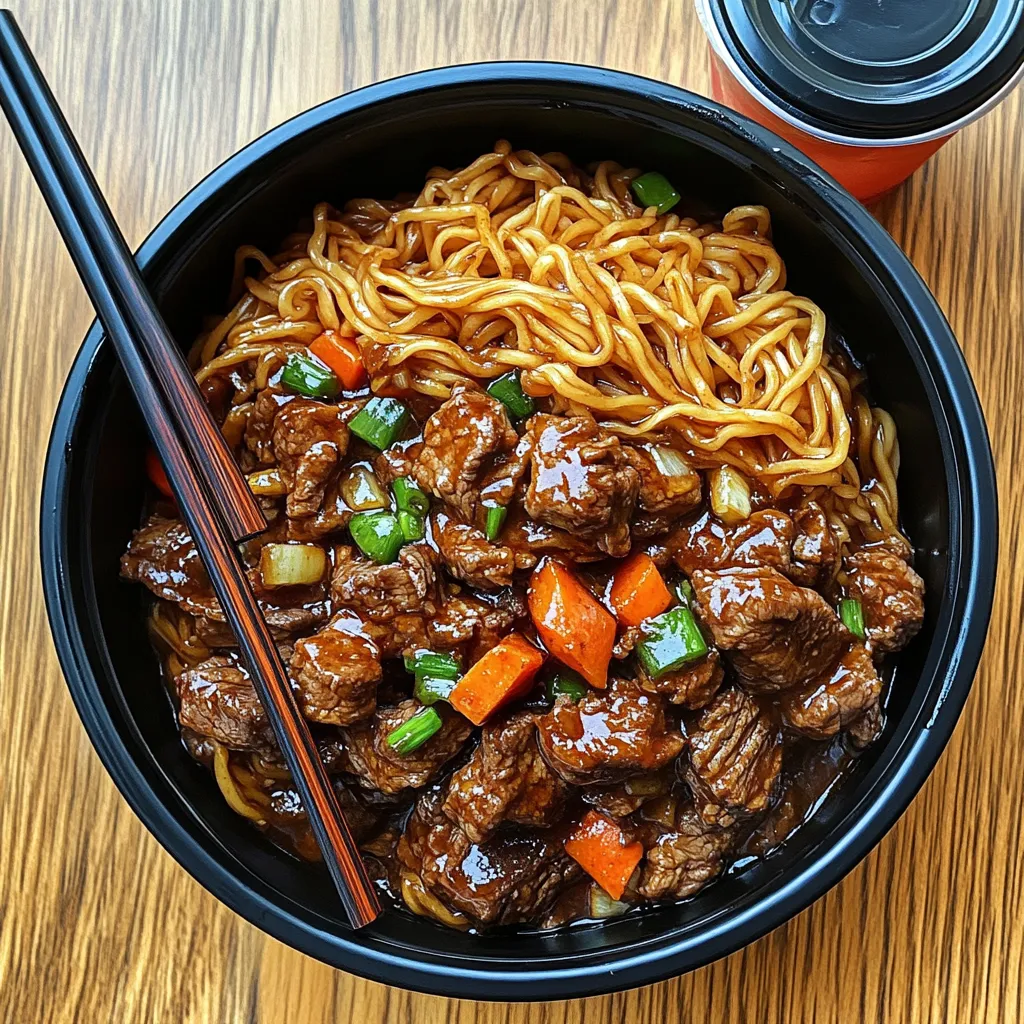 Mark
Mark
This sticky beef noodle dish has become my weeknight secret weapon when I need something delicious and satisfying without spending hours in the kitchen. The combination of tender beef, chewy noodles, and that irresistible sweet-savory sauce creates a restaurant-quality meal that my family requests constantly.
I first created this recipe when trying to recreate my favorite takeout dish during lockdown. What started as an experiment has become our Friday night tradition, with my kids now requesting "sticky noodles" weekly over pizza.
Ingredients
- Rice noodles: Provide the perfect chewy texture for soaking up all that delicious sauce. Rice noodles cook quickly and stay tender without becoming mushy.
- Beef sirloin or flank steak: Gives you the best texture when sliced thin against the grain. Look for pieces with some marbling for extra tenderness.
- Cornstarch: Creates that velvety coating on the beef that helps the sauce cling perfectly to each piece.
- Vegetable oil: With a high smoke point ensures your beef gets a good sear without burning.
- Red bell peppers: Add sweetness and a pop of color. Choose firm ones with glossy skin for the freshest flavor.
- Broccoli florets: Provide excellent texture contrast and absorb the sauce beautifully. Cut them to similar sizes for even cooking.
- Green onions: Bring a mild onion flavor that complements the beef perfectly. The white parts add flavor while cooking, and the green tops make a fresh garnish.
- Garlic cloves: Freshly minced just before cooking will release the most flavor.
- Fresh ginger: Adds that distinctive warming spice that makes Asian inspired dishes sing. Look for firm pieces with smooth skin.
- Soy sauce: Forms the savory base of our sticky sauce. Use low sodium if you prefer to control the salt level.
- Hoisin sauce: Adds complex sweetness and depth. This thick fermented sauce is a key ingredient for authentic flavor.
- Honey or brown sugar: Creates the sticky texture and balances the saltiness with natural sweetness.
- Rice vinegar: Brightens all the flavors with gentle acidity. Its mild flavor won't overpower the other ingredients.
- Sesame oil: Brings a nutty aroma that elevates the entire dish. A little goes a long way.
- Red pepper flakes: Add optional heat that you can adjust to your preference.
Step-by-Step Instructions
- Cook the Noodles:
- Fill a large pot with water and bring to a rolling boil. Add your rice noodles and cook according to package instructions, usually 4 to 7 minutes. Test one noodle to ensure its tender but still has some bite. Drain immediately and rinse with cold water to stop the cooking process and prevent sticking.
- Prepare the Beef:
- Slice your beef against the grain as thinly as possible for the most tender results. Toss the sliced beef in a bowl with cornstarch, making sure each piece is evenly coated. The cornstarch creates a protective layer that seals in juices and helps thicken our sauce. Heat your wok or large skillet until it is very hot, then add oil and swirl to coat. Arrange beef in a single layer without overcrowding and let it sear undisturbed for 2 minutes until deeply browned on one side before flipping. The high heat is crucial here to get that caramelization without overcooking the beef.
- Cook the Vegetables:
- Using the same pan with all those flavorful beef bits, add your remaining oil and toss in bell peppers and broccoli. Keep everything moving with a wooden spoon or spatula for 4 to 5 minutes. You want your vegetables to maintain some crispness while developing slight char marks. Add green onions, garlic and ginger only in the final minutes as they burn easily. When you can smell the fragrant aromatics wafting up, your vegetables are ready.
- Make the Sticky Sauce:
- Combine soy sauce, hoisin, honey, rice vinegar, sesame oil and pepper flakes in a bowl and whisk until completely smooth. The consistency should be pourable but slightly thick. This perfect balance of salty, sweet, tangy and spicy will coat every strand of noodle and piece of beef.
- Combine Everything:
- Return your beef to the pan with the vegetables, then add your cooked noodles. Pour the sauce over everything and toss continuously for about 2 minutes. The heat will thicken the sauce as it coats each component, creating that signature glossy stickiness. Keep tossing until everything is evenly coated and the sauce has thickened to your liking.

The cornstarch coating on the beef is my secret technique learned from Chinese cooking. This method called velveting creates an incredibly tender texture even with less expensive cuts of meat. I discovered this by accident when I ran out of flour one night and have never gone back to my old method.
Make Ahead and Storage
This sticky beef noodle dish actually improves with time as the flavors meld together in the refrigerator. You can prepare all the components separately up to two days ahead. Cook your noodles, cool them completely, and store with a tiny drizzle of oil to prevent sticking. Slice your beef and vegetables and keep them in separate containers. The sauce can be mixed and stored in a jar in the refrigerator for up to a week.

Customizing Your Noodles
This versatile recipe welcomes endless variations based on what you have available. For protein alternatives, try thinly sliced chicken thighs or peeled shrimp which both cook even faster than beef. For a vegetarian version, substitute the beef with pressed extra firm tofu or tender mushrooms that provide excellent meaty texture.
Serving Suggestions
Serve these sticky beef noodles family style in a large serving bowl with serving tongs for easy sharing. For a complete meal, pair with a simple cucumber salad dressed with rice vinegar and sesame oil to provide cooling contrast to the rich noodles.
Questions About Recipes
- → Can I substitute beef with another protein?
Yes, you can use chicken, pork, shrimp, or tofu as alternatives for the beef.
- → What type of noodles works best for this dish?
Rice noodles, lo mein, or udon noodles are great options for this recipe. Choose what you prefer.
- → How do I make this dish gluten-free?
To make it gluten-free, opt for gluten-free soy sauce and rice noodles.
- → Can I add more vegetables?
Yes, you can add snap peas, carrots, or baby corn for more variety.
- → How should I store and reheat leftovers?
Store leftovers in an airtight container in the fridge for up to 3 days. Reheat in a skillet or microwave until warmed through.
